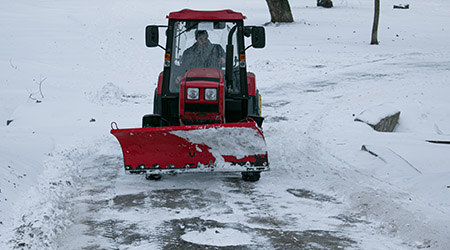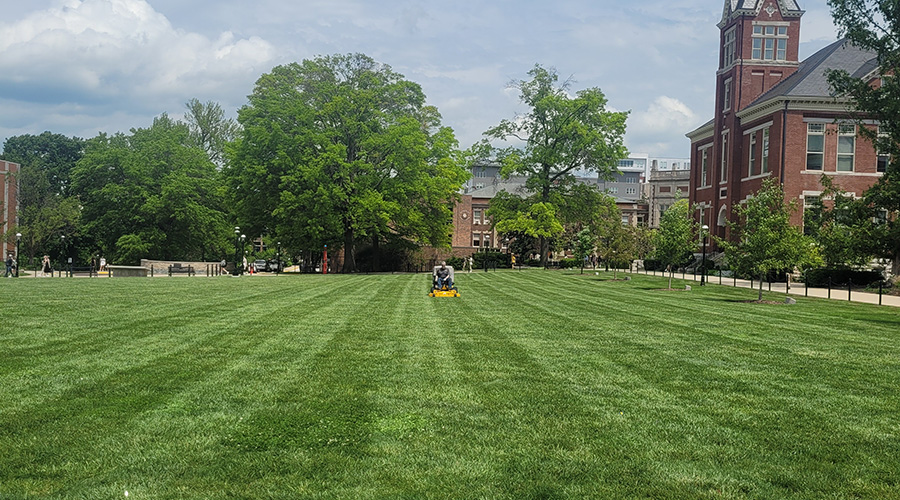Training, Good Maintenance Are Crucial to Snow and Ice Management
Making sure operators are proficient in snow-removal equipment, and keeping that equipment well maintained are two the most important aspects of a snow and ice management plan.
When it comes to snow and ice removal, the most important action any manager can take is to educate employees on the equipment they are operating. This step includes training operators to perform walk-arounds to identify worn or unsafe components.
What type of training is typically required? The type of training depends on the equipment being used.
“Managers should spend some time observing the operator to ensure they have proficient use of the snow removal equipment,” Dobson says. “This time would vary depending on the property in which they are looking to clear.”
For example, when training employees on zero-turn equipment with snow removal implements, it is similar to training them to operate a mower.
“Employees need to understand how much throttle they should be using,” Dobson says. “For example, a snow thrower might run at full throttle, whereas a broom might not need to run at full throttle to complete a task. Managers should take time reviewing height adjustment, steering, controls, safety features and safety guards on any piece of snow removal equipment.”
Nunez also says that before sending operators out to use the equipment, especially in inclement weather, it is essential to ensure that the operators are familiar with the operator’s manual for safe operation.
It is also important to familiarize staff with diagnostic error codes and the impact they have on equipment, Sandmann says. This includes calibrating spreaders to ensure the machines apply the proper amounts of materials at the right settings, as well as practicing with the equipment on the sites they intend to treat to become familiar with the challenges of the specific site and the equipment in working conditions.
Maintenance management
Maintaining snow and ice removal equipment is paramount to success.
“Routine pre-season and post-season preventive maintenance will extend the service life of any piece of equipment,” Sandmann says. “Education and training will help identify issues as they arise and prevent unnecessary wear and tear on equipment.”
What should operators pay attention to? On snowplows, they should look for cutting-edge wear, leakage in hydraulic cylinders, corroded or pitted cylinders, worn-down electrical connections, quill adjustments for blade travel, and controller functionality.
They should also ensure spreaders, augers and chains are properly greased and not worn, spinners are not damaged, and electrical connections are in good working order.
“Also, you want to ensure the machines are properly calibrated,” Sandmann says.
Effective maintenance of a plow or spreader involves ensuring that dialectic grease is applied to all connections in the off-season and during usage in season. It is important to ensure that all greaseable components are properly greased and working, Sandmann says. For plows, make sure the hydraulic reservoir is full with the correct type of fluid and the cutting edges are not excessively worn. For spreaders and plows, make sure that all electrical connections are solid with good grounds and do regular function tests on controllers to ensure proper operation.
Snow and ice equipment must be maintained regularly because winter conditions can change rapidly, Dobson says. Having a preventive maintenance schedule, easy access to service items on the equipment, and good parts availability all play a role in the up-time of the equipment.
“Managers should pay attention to any additional wear to equipment that can be caused by clearing conditions, salt or brine being applied and this can sometimes affect the life of some equipment,” Dobson says. “Managers should review if different fuel type or grease types would be better used during the winter months. The operator should also check belts and wear guards and be sure snow removal equipment is fully operational before clearing snow.”
One mistake that Dobson sees managers make when selecting and maintaining snow and ice equipment is evaluating the upfront cost of acquisition versus the cost of operation.
Many times, buying less expensive equipment does not offer the long return- on- investment grounds managers need.
“Equipment made of high-quality components, powder coat paint, ease of use and the ability to adapt to other implements play a role in a lower cost of operation,” Dobson says. “Managers need to be sure they have the horsepower needed for snow removal. Look for equipment that is easy to interchange into snow removal and reduce the number of engines and parts to warehouse.”
Before use, operators should check the plow and vehicle mounts for cracks and to make sure the plow is securely mounted to the vehicle. Operators also should tighten all fasteners, and verify that all cotter pins are in place before going out on the job.
“Operators should also check to ensure all electrical connections are clean, tight, and greased properly,” Nunez says. “If any rust is visible, repainting is encouraged to protect the exposed metal from the winter conditions. Finally, ensure all moving parts, including bearings, hinges, and pivot bolts, are well greased. To fight wear and corrosion on electrical connections, use dielectric grease on those components.”
Looking ahead
As advances in technology come along, managers are likely to see additional ergonomic improvements in winter cabs and controls for utility vehicles.
“Grounds managers should focus on quality equipment that provides a lower cost of operation and is comfortable for the operator,” Dobson says.
The ability to customize utility vehicles with a heated cab is also beneficial for winter to keep workers more comfortable and productive even in cold weather. Additionally, utility vehicles are designed to be compatible with a variety of attachments.
“Winter sidewalk maintenance has historically been labor- intensive work,” Nunez says. “However, there have been a lot of advancements that came forward in this space in recent years. The (utility vehicle), combined with purpose-built snow and ice control attachments, allow work to be mechanized. Working inside the cab is also one of the few solutions that protect the operator from the elements, helping increase operator comfort.”
Maura Keller is a freelance writer based in Minneapolis, Minnesota.
Related Topics:













